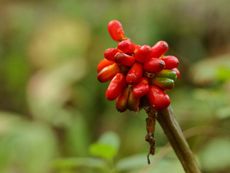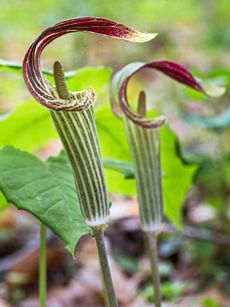Jack-In-The-Pulpit Plants: How To Grow Jack-In-The-Pulpit Wildflower


Jack-in-the-pulpit (Arisaema triphyllum) is a unique plant with an interesting growth habit. The structure that most people call the jack-in-the-pulpit flower is actually a tall stalk, or spadix, inside a hooded cup, or spathe. The true flowers are the tiny, green or yellow-tinged dots that line the spadix. The entire structure is surrounded by large, three-lobed leaves that often hide the spathe from view. In late summer or fall, the spathe falls off and the flowers give way to decorative wands of bright red berries.
About Jack-in-the-Pulpits
Jack-in-the-pulpit wildflower is native to the lower 48 states and parts of Canada. Native Americans harvested the roots for food, but they contain calcium oxalate crystals that cause blisters and painful irritations when eaten raw. To safely prepare the roots, first peel them and cut them into small pieces, then roast them at a low temperature for at least an hour. Growing jack-in-the-pulpit is easy in the right location. They grow wild in woodland environments and prefer a shady spot with moist or wet, slightly acidic soil that is rich in organic matter. These plants tolerate poorly-drained soil and make great additions to rain or bog gardens. Use Jack-in-the-pulpit in shade gardens or to naturalize the edges of woodland areas. Hostas and ferns make excellent companion plants.
How to Grow Jack-in-the-Pulpit
There is not much involved with growing Jack-in-the-pulpit plants. Plant container grown Jack-in-the-pulpit plants in spring or plant corms 6 inches (15 cm.) deep in fall. Plant seeds freshly harvested from ripe berries in spring. Plants grown from seeds have only one leaf the first year and it takes them three or more years to come to flower.
Caring for Jack-in-the-pulpit Wildflower
As easy as growing Jack-in-the-pulpit flower is, so is its care. The plant's survival depends on a moist, organically rich soil. Work a generous amount of compost in to the soil before planting and fertilize annually with additional compost. Use organic mulch such as bark, pine needles, or cocoa bean shells, and replace it every spring. Jack-in-the-pulpit plants are seldom bothered by insects or diseases, but are very attractive to slugs. Hand picking, traps, and slug baits are the easiest ways to deal with these pests. Place hiding places, such as boards and upturned flower pots, in the garden as traps and check them early in the morning. Drop the slugs in a bucket of soapy water to kill them. Read the label on slug baits carefully and choose one that won't harm children, pets, and wildlife. Knowing how to grow Jack-in-the-pulpit in the garden is a great way to enjoy the plant's unique appearance throughout the season.
Gardening tips, videos, info and more delivered right to your inbox!
Sign up for the Gardening Know How newsletter today and receive a free download of our most popular eBook "How to Grow Delicious Tomatoes."

Jackie Carroll has written over 500 articles for Gardening Know How on a wide range of topics.
-
 Urban Composting Guide: How To Compost In The Middle Of The City
Urban Composting Guide: How To Compost In The Middle Of The CityUrban composting does not have to be daunting. You can compost in the city, and maybe even try some urban worm composting!
By Mary Ellen Ellis
-
 Shrub Diseases And Pests To Watch Out For
Shrub Diseases And Pests To Watch Out ForShrub diseases and pests can be challenging. Learn how to recognize and eradicate them before they can present a danger to your plants.
By Susan Albert
-
 Jack In The Pulpit Seed Germination – Planting Jack In The Pulpit Seeds
Jack In The Pulpit Seed Germination – Planting Jack In The Pulpit SeedsYou can propagate Jack in the pulpit from seed with a little preparation, click to learn just how to plant Jack in the pulpit seeds.
By Amy Grant
-
 Propagating Jack-In-The-Pulpit: How To Propagate Jack-In-The-Pulpit Plants
Propagating Jack-In-The-Pulpit: How To Propagate Jack-In-The-Pulpit PlantsHow does jack-in-the-pulpit reproduce? Click this article to learn how to propagate jack-in-the-pulpit plants so you can enjoy more additions in the garden.
By Amy Grant